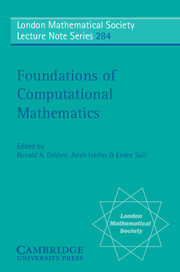Book contents
- Frontmatter
- Contents
- Preface
- Singularities and computation of minimizers for variational problems
- Adaptive finite element methods for flow problems
- Newton's method and some complexity aspects of the zero-finding problem
- Kronecker's smart, little black boxes
- Numerical analysis in Lie groups
- Feasibility control in nonlinear optimization
- Six lectures on the geometric integration of ODEs
- When are integration and discrepancy tractable?
- Moving frames — in geometry, algebra, computer vision, and numerical analysis
- Harmonic map flows and image processing
- Statistics from computations
- Simulation of stochastic processes and applications
- Real-time numerical solution to Duncan-Mortensen-Zakai equation
Moving frames — in geometry, algebra, computer vision, and numerical analysis
Published online by Cambridge University Press: 05 August 2013
- Frontmatter
- Contents
- Preface
- Singularities and computation of minimizers for variational problems
- Adaptive finite element methods for flow problems
- Newton's method and some complexity aspects of the zero-finding problem
- Kronecker's smart, little black boxes
- Numerical analysis in Lie groups
- Feasibility control in nonlinear optimization
- Six lectures on the geometric integration of ODEs
- When are integration and discrepancy tractable?
- Moving frames — in geometry, algebra, computer vision, and numerical analysis
- Harmonic map flows and image processing
- Statistics from computations
- Simulation of stochastic processes and applications
- Real-time numerical solution to Duncan-Mortensen-Zakai equation
Summary
Abstract
This paper surveys the new, algorithmic theory of moving frames developed by the author and M. Fels. Applications in geometry, computer vision, classical invariant theory, and numerical analysis are indicated.
Introduction
The method of moving frames (“repères mobiles”) was forged by Élie Cartan, [13, 14], into a powerful and algorithmic tool for studying the geometric properties of submanifolds and their invariants under the action of a transformation group. However, Cartan's methods remained incompletely understood and the applications were exclusively concentrated in classical differential geometry; see [22, 23, 26]. Three years ago, [20, 21], Mark Fels and I formulated a new approach to the moving frame theory that can be systematically applied to general transformation groups. The key idea is to formulate a moving frame as an equivariant map to the transformation group. All classical moving frames can be reinterpreted in this manner, but the new approach applies in far wider generality. Cartan's normalization procedure for the explicit construction of a moving frame relies on the choice of a cross-section to the group orbits. Building on these two simple ideas, one may algorithmically construct moving frames and complete systems of invariants for completely general group actions.
- Type
- Chapter
- Information
- Foundations of Computational Mathematics , pp. 267 - 298Publisher: Cambridge University PressPrint publication year: 2001
- 11
- Cited by

